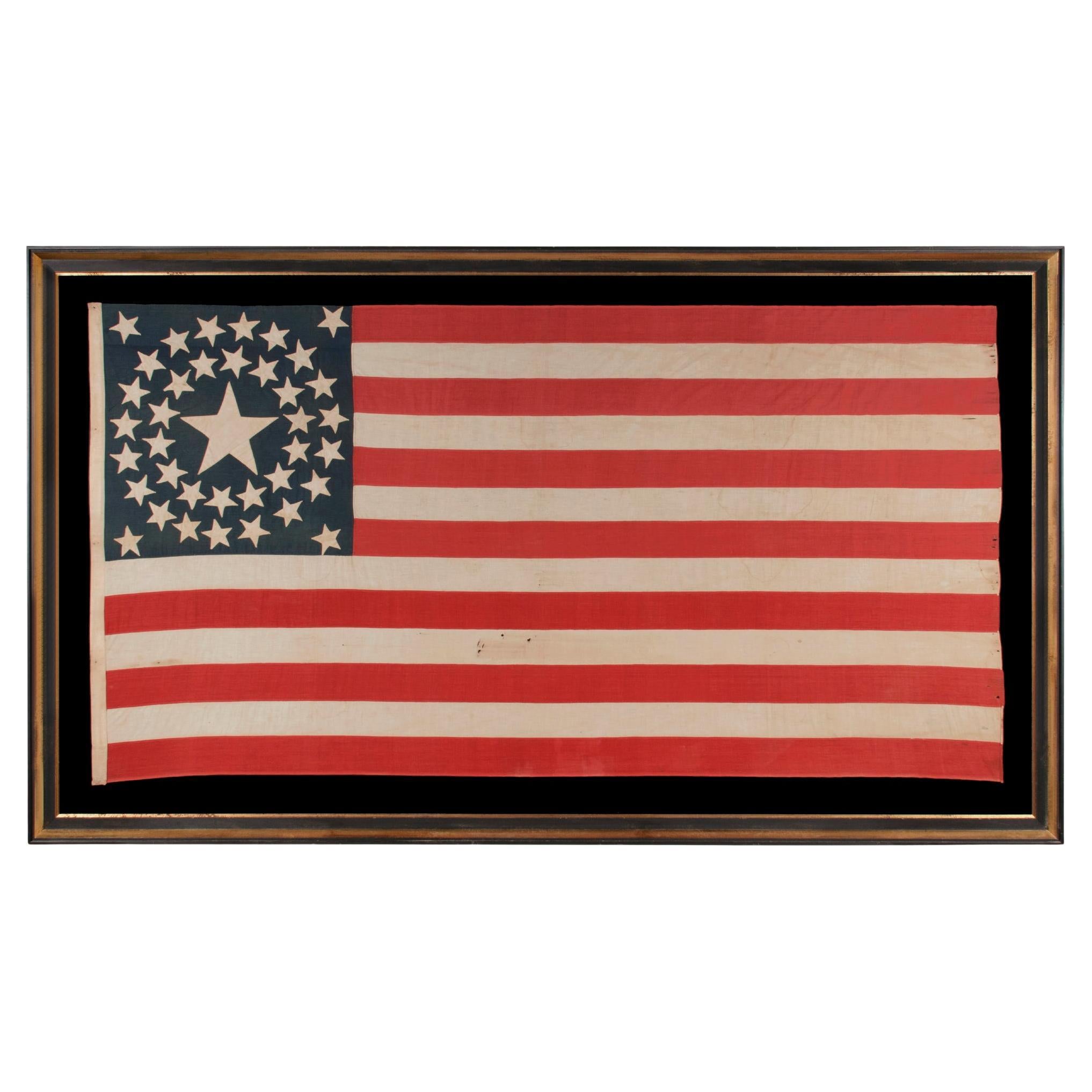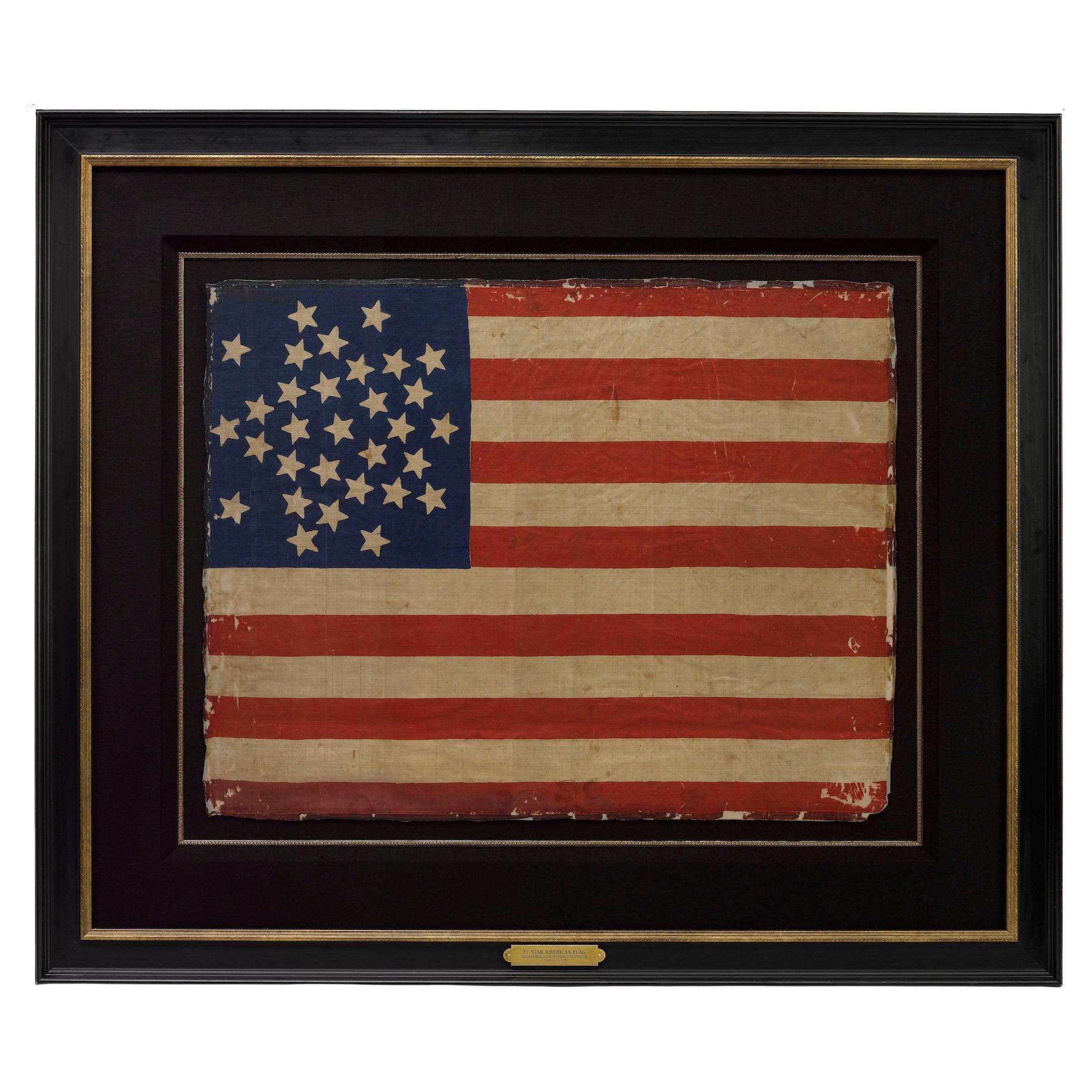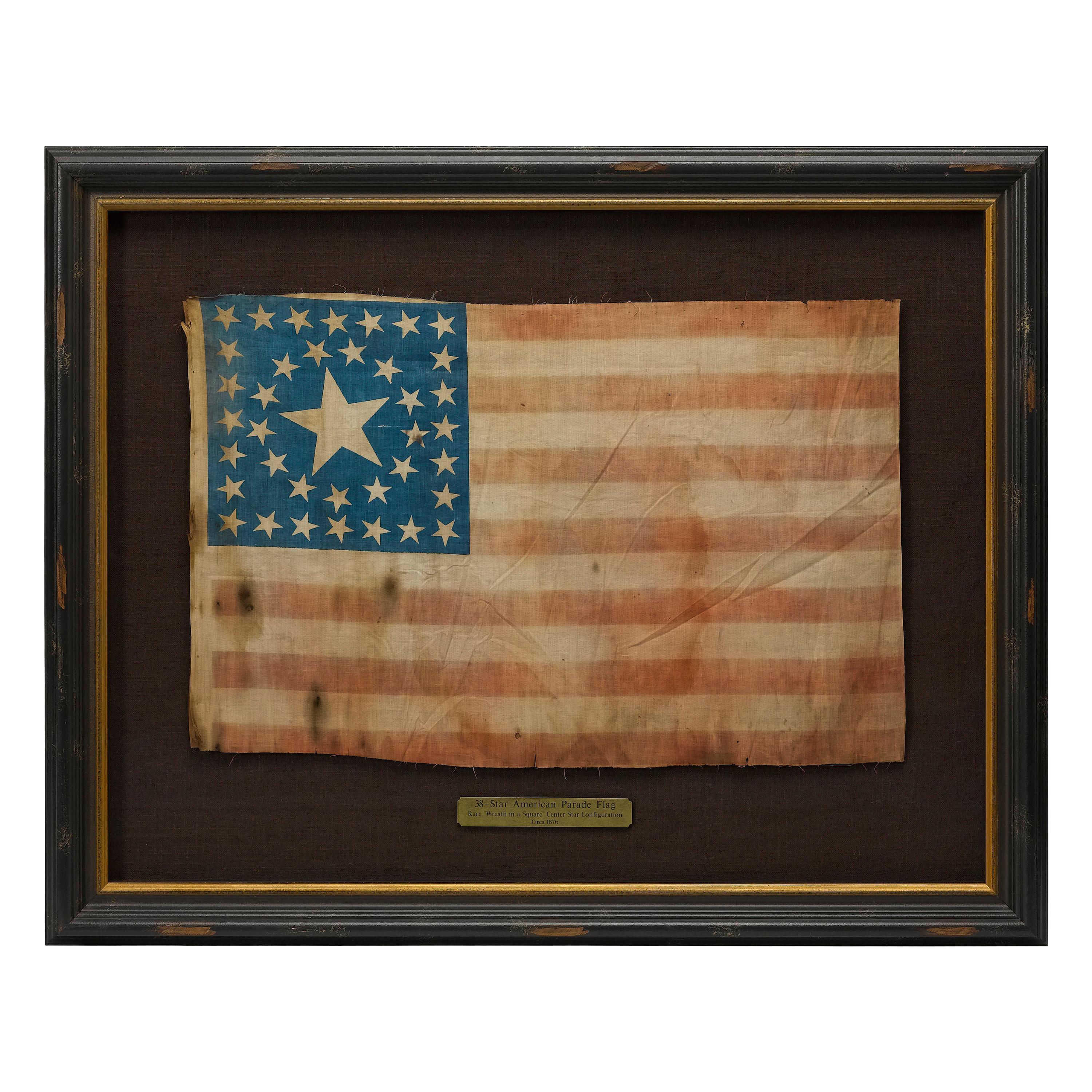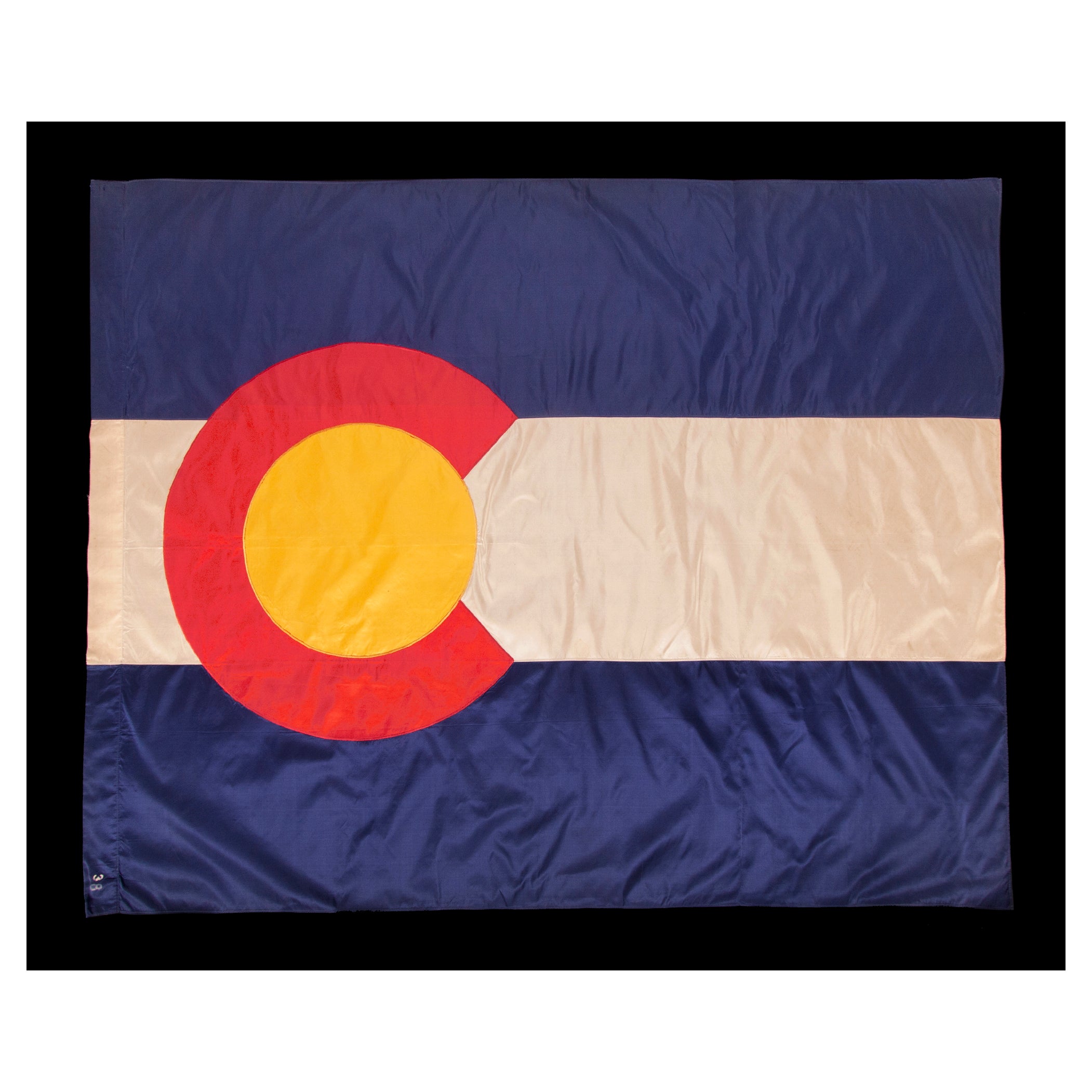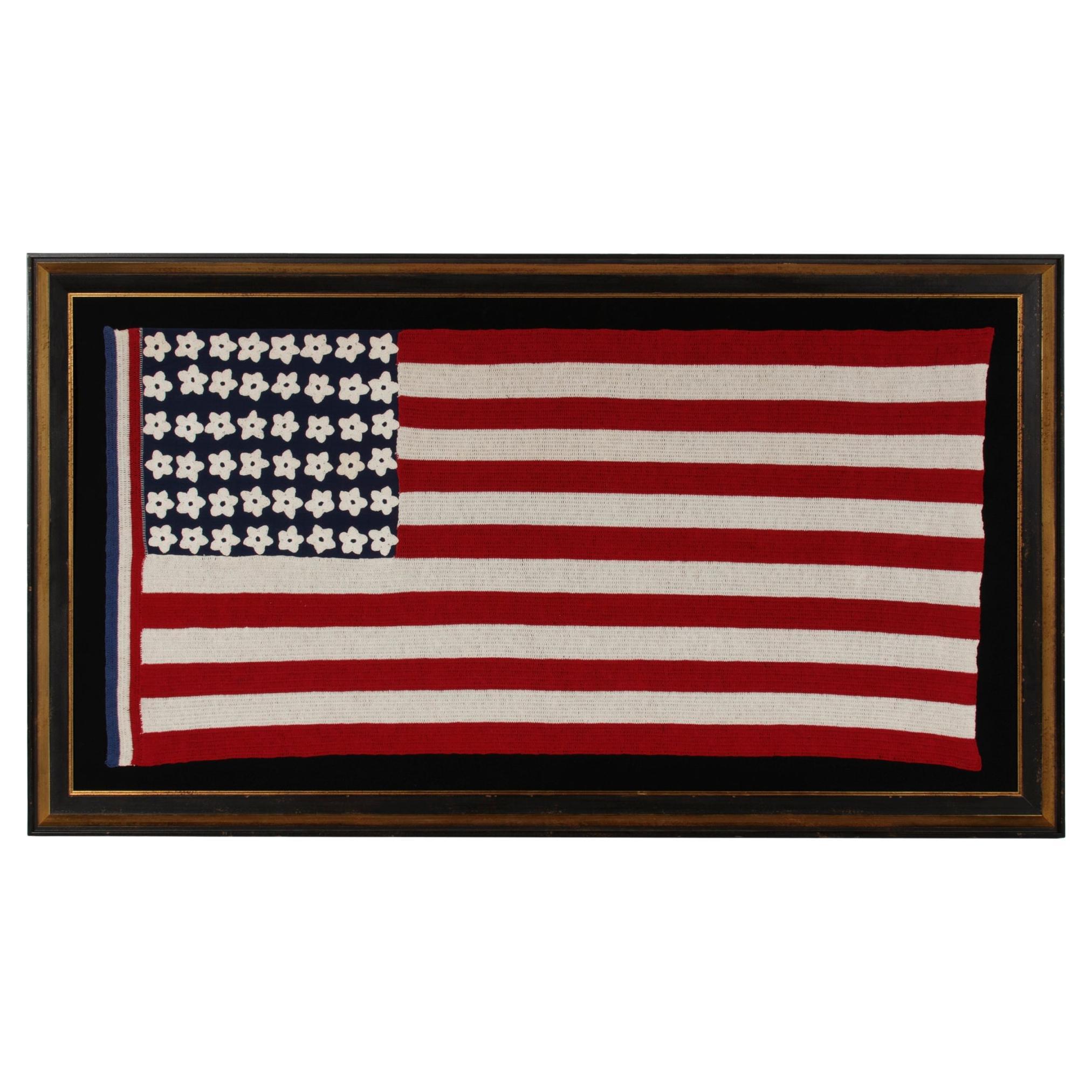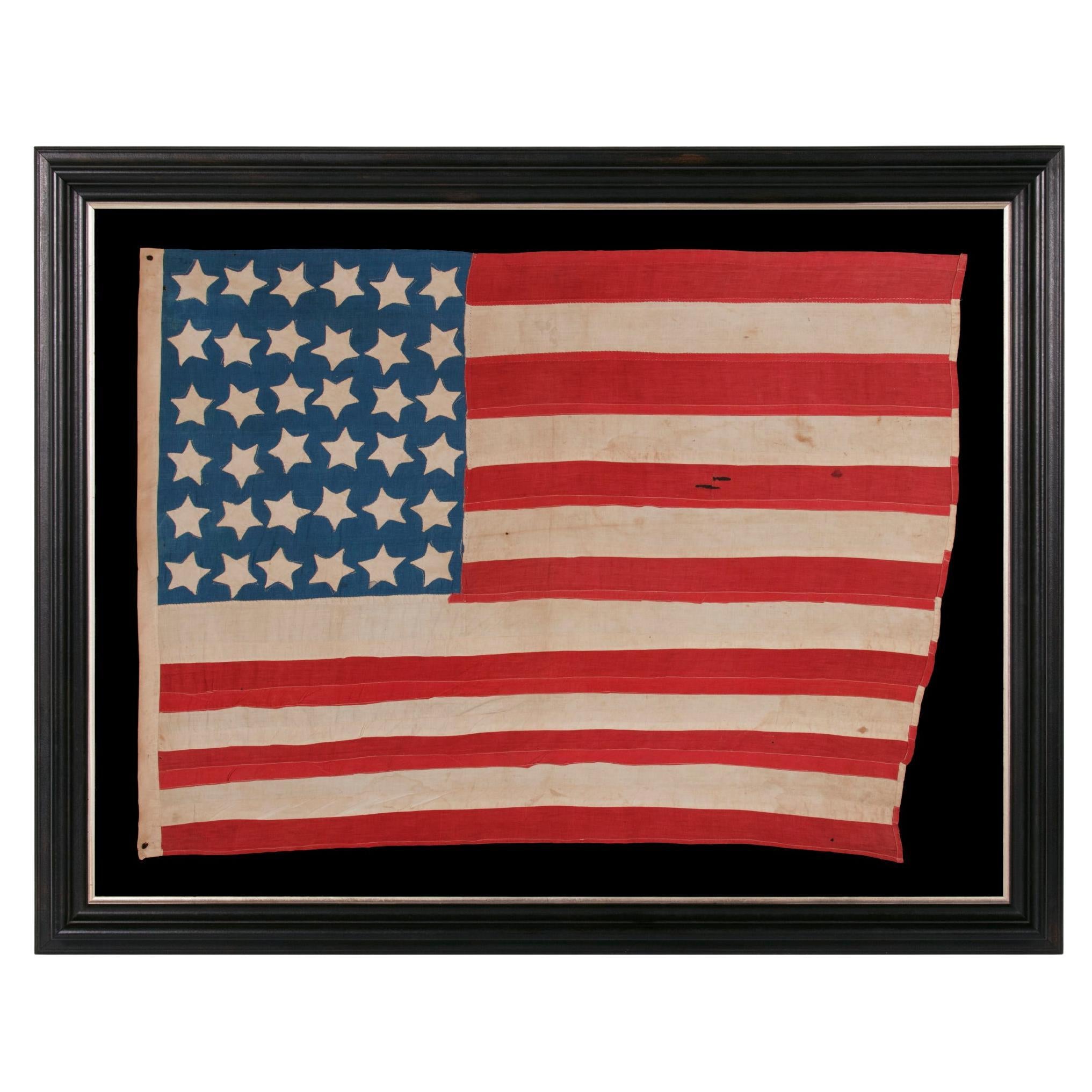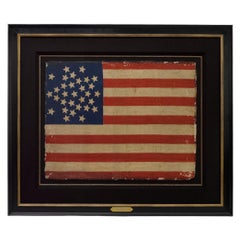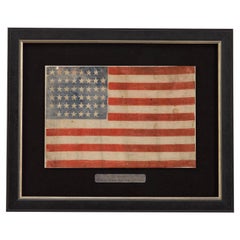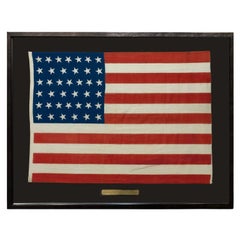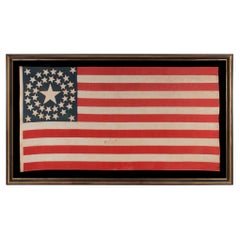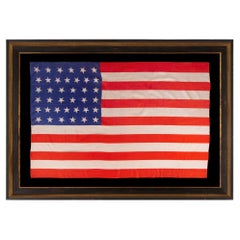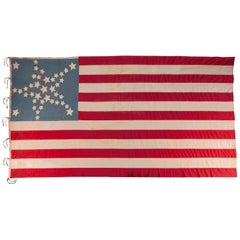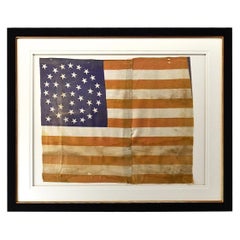
38-Star Medallion Pattern Flag, Celebrating Colorado Statehood
View Similar Items
Want more images or videos?
Request additional images or videos from the seller
1 of 5
38-Star Medallion Pattern Flag, Celebrating Colorado Statehood
$6,500List Price
About the Item
- Dimensions:Height: 35 in (88.9 cm)Width: 43 in (109.22 cm)Depth: 1.5 in (3.81 cm)
- Materials and Techniques:
- Place of Origin:
- Period:
- Date of Manufacture:Late 19th Century
- Condition:Wear consistent with age and use. Minor fading. Some fading to the original colors, creasing, as well as staining and toning noticeable in bottom third of field. Fading to blue canton at left. Small holes across top of field. Flag has a few hand sewn repairs and stains.
- Seller Location:Colorado Springs, CO
- Reference Number:Seller: F4191stDibs: LU909723958112
About the Seller
4.9
Platinum Seller
Premium sellers with a 4.7+ rating and 24-hour response times
Established in 2010
1stDibs seller since 2011
456 sales on 1stDibs
Typical response time: 4 hours
Authenticity Guarantee
In the unlikely event there’s an issue with an item’s authenticity, contact us within 1 year for a full refund. DetailsMoney-Back Guarantee
If your item is not as described, is damaged in transit, or does not arrive, contact us within 7 days for a full refund. Details24-Hour Cancellation
You have a 24-hour grace period in which to reconsider your purchase, with no questions asked.Vetted Professional Sellers
Our world-class sellers must adhere to strict standards for service and quality, maintaining the integrity of our listings.Price-Match Guarantee
If you find that a seller listed the same item for a lower price elsewhere, we’ll match it.Trusted Global Delivery
Our best-in-class carrier network provides specialized shipping options worldwide, including custom delivery.More From This Seller
View All31-Star Printed American Flag, Celebrating California Statehood, Circa 1850
Located in Colorado Springs, CO
This is a rare 31-star medallion printed American flag, celebrating the addition of California to the Union. The flag is printed on silk and has a spectacular “Great Star” canton pat...
Category
Antique 1850s American Political and Patriotic Memorabilia
Materials
Silk
46-Star Printed American Flag Waver, Celebrating Oklahoma Statehood
Located in Colorado Springs, CO
Presented is an American flag waver with 46 stars. The printed flag features a row pattern of stars against a dark blue canton, with thirteen red and white stripes completing the des...
Category
Antique Early 1900s American Political and Patriotic Memorabilia
Materials
Fabric
45-Star American Flag, Printed on Cotton, Celebrating Utah Statehood, 1896-1908
Located in Colorado Springs, CO
This 45-star United States flag celebrates the statehood of Utah. 45-star flags served as the official American flag from 1896-1908. This particular flag was flown as a parade flag. ...
Category
Antique 1890s American Political and Patriotic Memorabilia
Materials
Cotton
39-Star Antique American Flag with 'Whimsical' Star Pattern, 1889
Located in Colorado Springs, CO
This is a 39-star unofficial American flag, handmade and printed on cotton. The flag dates to 1889 and has a unique history, thanks to its rare star-count.
The flag’s canton is prin...
Category
Antique 1880s American Political and Patriotic Memorabilia
Materials
Cotton
38-Star Antique American Flag with Unique Canton, circa 1876-1890
Located in Colorado Springs, CO
This is a striking 38-star American flag. The flag dates to 1876-1890, when Colorado (represented by the large star in the center of the flag’s canton) joined the Union as the 38th s...
Category
Antique Late 19th Century American Political and Patriotic Memorabilia
Materials
Muslin
46-Star American Flag Printed in Drum Star Configuration
Located in Colorado Springs, CO
This is an original 46-Star American parade flag, celebrating Oklahoma statehood. Each star on the flag's canton represents a state in the Union at the time. The official flag design would update every July 4th, to include any new states added to the Union in the past year. Oklahoma, the 46th state, entered the Union on November 16, 1907. As such, this 46–star flag was the official flag of the United States from July 4, 1908, until July 4, 1912.
The silk flag has a dark blue canton with 46 white printed stars. The stars are printed in an 7-8-8-8-8-7 row configuration, or “Drum design.” The flag design is completed with 13 alternating red and white stripes, each stripe representing one of the original thirteen colonies.
The land that comprises Oklahoma today was added to the United States as part of the Louisiana Purchase of 1803. Throughout the 19th century, the U.S. government relocated Indian tribes from the southeastern United States to the area, and by 1900, over 30 Indian tribes had been moved to what was originally called the Indian Territories. At the same time, ranchers in Texas began to move into the area in search of new pasture lands. Although stipulations in the Indian Relocation Act agreed that the land would forever be Indian Territory, the promise of fertile farmland trumped the government’s promise of sovereignty.
On April 22, 1889, they opened the land to settlement by homesteaders, creating a land run in which settlers, called “Boomers,” were allowed to cross the Texas or Arkansas border at a particular hour to claim homesteads. Settlers who illegally crossed the border earlier to stake prime land were called “sooners,” which eventually became the state’s nickname. Wagons and the Santa Fe railroad carried cartloads of men and women to blank town sites and building plots, creating ten thousand-people communities in a matter of days. The following year, the region was further divided into Indian Territory and Oklahoma Territory...
Category
Vintage 1910s American Political and Patriotic Memorabilia
Materials
Silk
You May Also Like
38 Star Antique Flag, Stars in Double Wreath Pattern, Colorado Statehood 1876-89
Located in York County, PA
38 STAR ANTIQUE AMERICAN FLAG WITH A DOUBLE-WREATH CONFIGURATION THAT FEATURES AN ENORMOUS CENTER STAR, REFLECTS THE PERIOD OF COLORADO STATEHOOD, 1876-1889:
38 star American national flag, made entirely of plain weave cotton. The stars are arranged in a medallion configuration. This features an enormous center star, surrounded by two wreaths of much smaller stars, with a flanking star in each corner of the blue canton. The sort of disparity here, present in the scale of the large star, versus those around it, is both exceptionally unusual and graphically dynamic.
Colorado became the 38th state on August 1st, 1876. This was the year of our nation’s centennial. Per the Third Flag Act of 1818, stars were not officially added until the 4th of July following a state's addition. For this reason, 37 remained the official star count for the American flag until part way through the following year. Flag-making was a competitive venture, however, and few flag-makers would have continued to produce 37 star flags when their competitors were making 38’s. Many flag-makers added a 38th star before Colorado entered the Union, in the early part of 1876, or possibly even prior. In fact, many makers of printed flags, called parade flags or hand-wavers, were actually producing flags in the 39 star count, in hopeful anticipation of the addition of two more Western Territories instead of one.
It is for these reasons that 38, 39, and 13 stars, to representing the original 13 colonies, are most often seen on flags displayed at the Centennial International Exhibition. Hosted in Philadelphia, this enormous event was our nation’s first World’s Fair, lasted for a duration of six months, and served as the nucleus of celebrations held to honor America’s 100-year anniversary of independence. The 38 star flag became official on July 4th, 1877 and was generally used until the 39th state was added in November of 1889.
This is probably a homemade flag, though sewn by a very skilled hand, or possibly, by two different individuals. The stripes are pieced and sewn entirely by hand, with remarkable care and precision. The canton is constructed of two lengths of blue fabric, that have been joined with treadle stitching. This was joined to the striped field by hand. The stars are double-appliquéd (applied to both sides) with treadle stitching. There is a treadle-sewn, cotton binding along the hoist, with five, hand-sewn grommets.
It is extremely unusual to encounter this combination of sewing methods. Soon after the sewing machine was mass-marketed, in the mid-1850’s, flag-makers both public and private made good use of treadle machines, to join stripes, when constructing American flags. During the Civil War (1861-65), most stripes were treadle-sewn. Stars were another matter. Until the advent of electric machines...
Category
Antique Late 19th Century American Political and Patriotic Memorabilia
Materials
Cotton
38 Star Parade Flag with Whimsical 6-Pointed Stars, Colorado Statehood
Located in York County, PA
38 WHIMSICAL STARS, WITH 6-POINTED PROFILES, SIMILAR TO THE STAR OF DAVID, ON AN ANTIQUE AMERICAN FLAG OF THE CENTENNIAL ERA; A REMARKABLE SPECIMEN, ONE-OF-A-KIND AMONG KNOWN EXAMPLE...
Category
Antique Late 19th Century American Political and Patriotic Memorabilia
Materials
Cotton
Price Upon Request
38 Star Antique American Flag, Colorado Statehood, circa 1876-1889
Located in York County, PA
38 star antique American parade flag with scattered star orientation, made of silk, with generous scale and vivid colors, Colorado Statehood, 1876-1889
38 star American national p...
Category
Antique Late 19th Century American Political and Patriotic Memorabilia
Materials
Silk
Price Upon Request
34 Star American flag, Updated to 39 Stars, with Stars in a Great Star Pattern
Located in York County, PA
34 STARS IN A WHIMSICAL RENDITION OF THE GREAT STAR PATTERN, ON A CIVIL WAR PERIOD FLAG WITH A CORNFLOWER BLUE CANTON, UPDATED TO 39 STARS IN 1876
34 star American national flag with additional stars added and one of the most stunning graphic designs I have ever seen in early flag-making. The original pattern was comprised of a circle of 5 large stars, and triangular arms made of smaller stars. These are noticeable pointy and bent like the arms of a starfish. Made of cotton, the stars are hand-sewn and double-appliquéd to a fantastic, cornflower blue canton, a color common to Civil War uniforms...
Category
Antique 1870s American Political and Patriotic Memorabilia
Materials
Cotton
Price Upon Request
Free Shipping
Antique American Flag, 32 Stars, Minnesota Statehood, circa 1858-59
Located in York County, PA
32 STARS IN A VERY UNUSUAL NOTCHED VERSION OF THE “GREAT STAR” PATTERN, WITH TWO STARS ABSENT AT THE EXTREME POINTS OF EACH ARM, MADE IN THE PERIOD WHEN MINNESOTA JOINED THE UNION AS...
Category
Antique 1850s American Political and Patriotic Memorabilia
Materials
Cotton
Colorado State Flag, Made of Silk, circa 1911-1920
Located in York County, PA
COLORADO STATE FLAG OF EXCEPTIONAL QUALITY, MADE OF SILK, CIRCA 1911-1920’s, EXTRAORDINARILY RARE IN THIS PERIOD AND THE EARLIEST EXAMPLE THAT I HAVE EVER ENCOUNTERED
Early state flags are few and far between. While I am asked for them constantly, most states did not actually have official flags until the 20th century.
On May 6th, 1911, Colorado became among the last to adopt a design. The project of doing so was spearheaded by the Denver Chapter of the Daughters of the American Revolution. The bill was introduced by Senator W.H. Sharply and adopted by the Eighteenth General Assembly. The artwork was the product of A.C. [Andrew Carlisle] Carson, President of the Ohio Society of Colorado. The meanings behind the elements in the design are as follows: The large letter "C" stands for Colorado and simultaneously for the Centennial State (Colorado entered the Union in 1876, the year in which our nation celebrated its 100th anniversary of independence), as well as the Columbine State (reflecting the state flower). The red color is included due to the fact that the word Colorado translates to scarlet or red in Spanish. The circle represents the sun, while the gold color symbolizes all-the-year sunshine, Colorado’s status as the greatest gold state, and one Columbine color. It was also included so that the Colorado state flag would have one more color than the U.S. flag. The color white reflects Colorado’s status as the greatest silver state, its eternal mountain snow, and one Columbine color. Lastly, the shade of Yale blue symbolizes all-the-year blue sky and one Columbine Color. Members of the D.A.R. were proud to note that this was also their color.
Made sometime between the initial year of the adoption of this design and the 1920’s, this particular flag is the earliest Colorado example that I have ever encountered. The blue and white bars, red “C,” and golden circle are a’’ made of silk taffeta. This was a costly fabric, reserved for the best material a flag-maker produced. The flag is constructed in the manner of a battle flag, to be carried on foot. Squarish in its overall profile, silk was the fabric of choice for flags employed in this function, due to the fact that it was light weight, and thus practical for hand-carrying, while simultaneously formal in appearance, appropriate for the sort of ceremonial use that military presentation often demands. The style of the hoist is also typical for field or parade use. Here the fabric was rolled over to form an open sleeve, through which a wooden staff could be inserted. The sleeve is lined on the interior with black cotton. Leather tabs, at the top and bottom, fit over metal posts on the staff, designed to accept them, to fix the flag in its proper position.
The bars were pieced and joined with lineal machine stitching. The hoist and fly ends were finished and hemmed by the same method. The devices are double-appliquéd (applied to both sides) with a machine buttonhole / blanket stitch. Though machines that produced buttonholes were, remarkably, available alongside the earliest standard machines, in the 1850’s and 60’s, the use of this sort of stitch in a running format, for appliqué work, remained highly unusual, even as late as the first half of the twentieth century, probably because it used a ton of thread when compared to the zigzag or satin stitch. It could be expected to appear more often in the hands of a maker of very fine flags, that employed embroidery machines and commissioned custom, fancy work of all sorts. Though unsigned—in no way uncommon in early examples, which were seldom signed—that is precisely the sort of firm that produced the Colorado flag...
Category
Early 20th Century American Political and Patriotic Memorabilia
Materials
Silk
Price Upon Request
Recently Viewed
View AllMore Ways To Browse
Western Cowboy Memorabilia
Antique Furniture Winchester
Used Flag Poles
Ulysses S Grant
Antique Sewing Machines
Fire Memorabilia
German Glass Christmas Ornaments
Brass Shell Casing
German Christmas Santa
Neil Armstrong
Queen Elizabeth Coronation
Music Memorabilia
Victorian Advertising
King Edward Coronation
Antique German Feather Trees
Antique Coffe Grinder
Antique Coffee Grinder
Cash Registers Used
